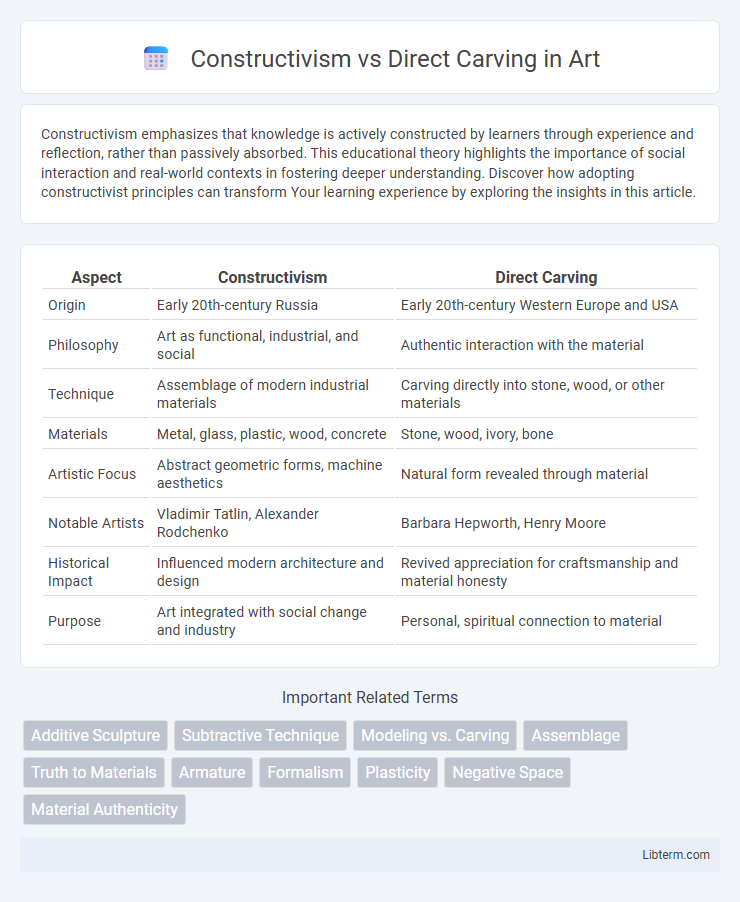Constructivism emphasizes that knowledge is actively constructed by learners through experience and reflection, rather than passively absorbed. This educational theory highlights the importance of social interaction and real-world contexts in fostering deeper understanding. Discover how adopting constructivist principles can transform Your learning experience by exploring the insights in this article.
Table of Comparison
| Aspect | Constructivism | Direct Carving |
|---|---|---|
| Origin | Early 20th-century Russia | Early 20th-century Western Europe and USA |
| Philosophy | Art as functional, industrial, and social | Authentic interaction with the material |
| Technique | Assemblage of modern industrial materials | Carving directly into stone, wood, or other materials |
| Materials | Metal, glass, plastic, wood, concrete | Stone, wood, ivory, bone |
| Artistic Focus | Abstract geometric forms, machine aesthetics | Natural form revealed through material |
| Notable Artists | Vladimir Tatlin, Alexander Rodchenko | Barbara Hepworth, Henry Moore |
| Historical Impact | Influenced modern architecture and design | Revived appreciation for craftsmanship and material honesty |
| Purpose | Art integrated with social change and industry | Personal, spiritual connection to material |
Introduction to Sculptural Approaches
Constructivism emphasizes abstract, geometric forms often assembled from industrial materials, promoting an architectural and mechanical aesthetic in sculpture. Direct carving involves carving directly into materials like wood or stone, highlighting the artist's spontaneous interaction with the medium and its natural properties. These contrasting sculptural approaches illustrate the divergence between planned assemblage and intuitive material exploration.
Defining Constructivism in Sculpture
Constructivism in sculpture emerged in early 20th-century Russia, characterized by abstract, geometric forms and an emphasis on industrial materials such as metal, glass, and wood. This movement focused on functionalism and the integration of art into everyday life, rejecting traditional sculptural techniques and figurative representation. In contrast, direct carving emphasized spontaneity and material integrity by shaping stone or wood intuitively without preliminary models.
What is Direct Carving?
Direct carving is a sculptural technique involving the artist working directly on the material, such as wood or stone, without preliminary models or maquettes. This method emphasizes spontaneity and a deeper connection to the medium, allowing the natural texture and form of the material to influence the final work. Unlike constructivism, which relies on assembling parts and planned design, direct carving celebrates immediacy and tactile interaction with the sculpture's raw surface.
Historical Contexts of Both Methods
Constructivism emerged in early 20th-century Russia, reflecting industrial modernization and political revolution, emphasizing abstract, geometric forms constructed from modern materials like steel and glass. Direct Carving, prominent in early 20th-century Western sculpture, revived ancient carving traditions by emphasizing the artist's intimate engagement with stone or wood, reacting against industrial mass production. Both methods reflect distinct historical contexts: Constructivism aligns with avant-garde political ideologies and mechanization, while Direct Carving connects to artistic authenticity and material integrity during a period of rapid modernization.
Key Artists and Manifestos
Constructivism emerged in Russia with artists like Vladimir Tatlin and Alexander Rodchenko advocating for art as a practice rooted in social purpose and industrial materials, emphasizing geometric abstraction and functional design. Direct Carving, popularized by sculptors such as Constantin Brancusi and Barbara Hepworth, focused on the artist's physical interaction with raw materials, highlighting form and texture without preliminary models or mechanized aids. Manifestos for Constructivism, notably the 1920 "Realistic Manifesto" by Naum Gabo and Antoine Pevsner, called for the integration of art and technology, while proponents of Direct Carving often rejected fabrication processes to emphasize authenticity and the spiritual essence of materials.
Materials and Techniques Compared
Constructivism emphasizes industrial materials such as steel, glass, and plastic, utilizing techniques like welding, assembling, and fabrication to create abstract, geometric forms. Direct Carving relies on traditional materials like stone, wood, or marble, with sculptors employing chisels, hammers, and rasping tools to shape the work intuitively from the original block. Constructivist works often showcase mechanical precision and modularity, whereas Direct Carving highlights the natural textures and inherent qualities of the material through hands-on craftsmanship.
Philosophical Foundations and Aesthetics
Constructivism emphasizes the use of industrial materials and geometric forms, reflecting a philosophy rooted in functionalism and social purpose, where art serves as a means to construct a new society. Direct Carving prioritizes the intrinsic qualities of the material and the artist's immediate interaction with it, embodying a philosophy of authenticity and spontaneity that highlights the beauty of natural textures and irregularities. Aesthetically, Constructivist works are characterized by precision, modularity, and abstraction, while Direct Carving artworks showcase organic forms, tactile surfaces, and an intimate connection between artist and medium.
Influence on Contemporary Sculpture
Constructivism revolutionized contemporary sculpture by emphasizing abstraction, industrial materials, and the integration of art with technology, inspiring artists to explore dynamic spatial relationships and modern aesthetics. Direct Carving reintroduced a focus on the artist's hand and material authenticity, fostering a tactile connection with natural stone or wood that influenced modern sculptors to prioritize form and texture in their work. Together, these movements shaped diverse approaches in contemporary sculpture, balancing conceptual innovation with material engagement.
Pros and Cons of Each Approach
Constructivism emphasizes assembling and welding materials, offering flexibility in design and the ability to create dynamic, complex shapes, but it can be time-consuming and requires technical skills in metalwork or welding. Direct Carving involves sculpting directly into materials like wood or stone, allowing for a tactile connection with the medium and spontaneous creativity, though it limits corrections and demands precision since errors are often irreversible. Each approach caters to different artistic goals, with Constructivism favoring industrial aesthetics and modularity, while Direct Carving emphasizes material integrity and traditional craftsmanship.
Legacy and Future Directions in Sculpture
Constructivism's legacy lies in its embrace of industrial materials and geometric abstraction, shaping modern sculpture through functional and socially engaged art. Direct Carving, by emphasizing the artist's intimate interaction with raw materials, champions authenticity and spontaneity, influencing contemporary sculptors seeking organic expression. Future directions in sculpture blend these approaches, integrating digital fabrication with hands-on craftsmanship to expand creative possibilities and cultural relevance.
Constructivism Infographic

 libterm.com
libterm.com